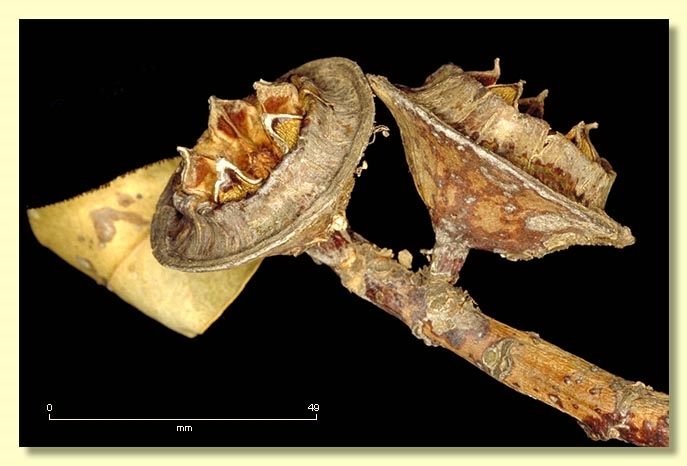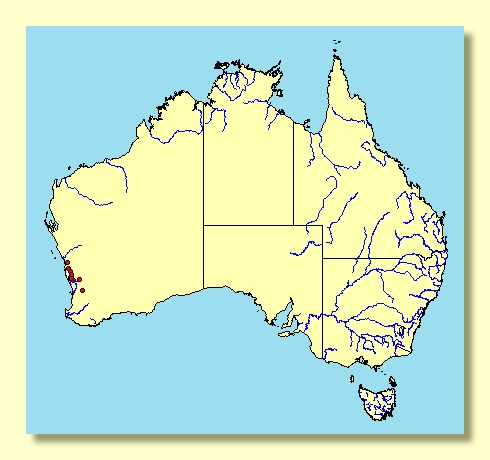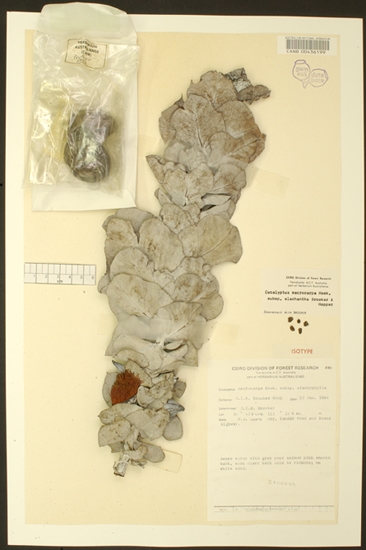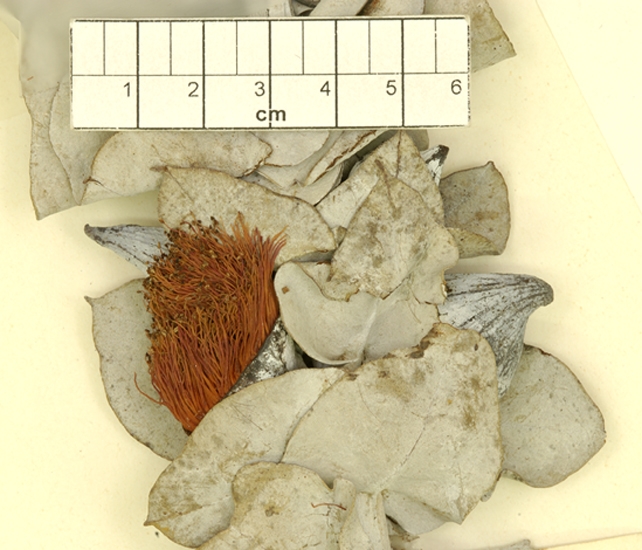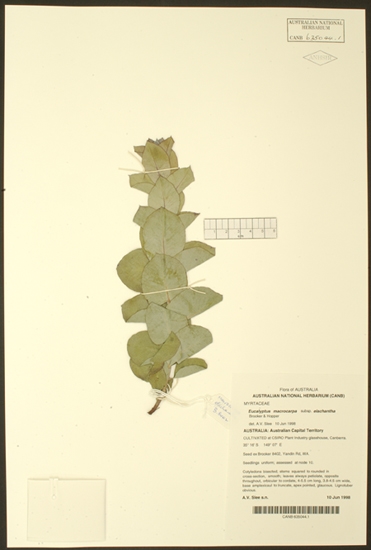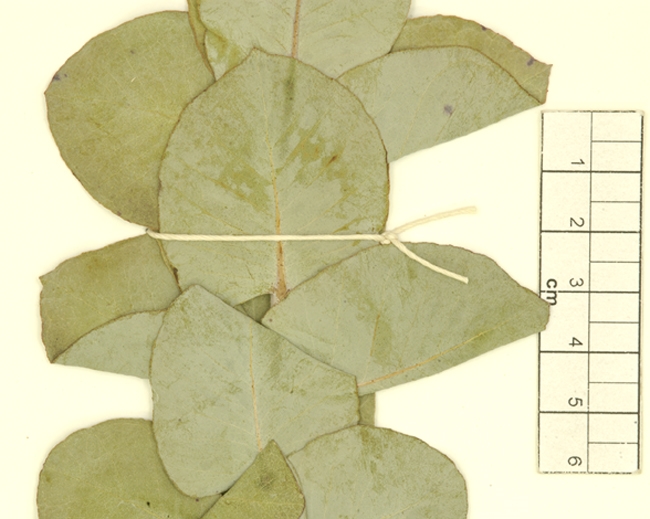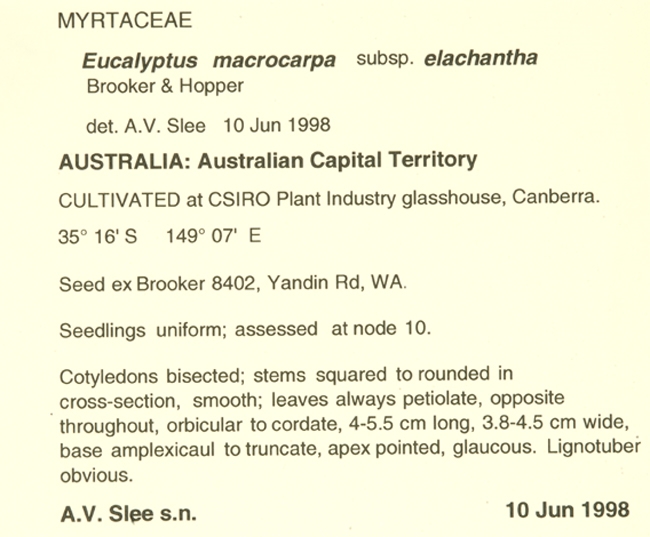Euclid - Online edition
Eucalyptus macrocarpa subsp. elachantha
Eucalyptus | Symphyomyrtus | Bisectae | Destitutae | Curviptera | Xylocarpae
Bark smooth throughout, shiny yellowish brown and grey-brown, shedding in short ribbons.
Branchlets glaucous; lacking oil glands in the pith.
Juvenile growth (coppice or field seedlings to 50 cm): stems square or rounded in cross-section, glaucous.
Crown formed of juvenile leaves which are typically opposite, sessile, amplexicaul, cordate to oblong, 5.5–8.5 cm long, 3.5–5 cm wide, margin entire, rarely subcrenulate, apex usually rounded to acute, rarely emarginate, concolorous, dull, pale whitish grey due to copious surface wax, side-veins greater than 45° to midrib, densely reticulate, intramarginal vein remote from margin, oil glands moderately numerous, intersectional.
Inflorescence axillary unbranched, peduncles 0.1–0.7 cm long; bud solitary, sessile or shortly and stoutly pedicellate, pedicels 0–0.5 cm long. Mature buds ovoid (4–5.5 cm long, 2.5–3 cm wide), glaucous, finely ribbed longitudinally to smooth, scar present, operculum beaked (3.2–3.8 cm long), outer stamens oblique, some inner stamens inflexed, filaments red (rarely creamy white), anthers cuboid, yellow, dorsifixed, dehiscing by longitudinal slits, style long and more or less straight, stigma blunt, locules 4 or 5, the placentae each with 8 or 10 vertical rows of ovules, with a narrow central gap. Flowers red rarely creamy white.
Fruit sessile, broadly and shallowly obconical, 1.2–2 cm long, 3.3–4.5 cm wide, disc slightly to steeply raised, oblique, valves 4 or 5, exserted.
Seeds pale straw-brown to pale grey-brown, 3–6 mm long, more or less pyramidal with prominent ridges and a conspicuous encircling marginal flange ca 1 mm wide, dorsal surface smooth to shallowly reticulate, hilum terminal.
Cultivated seedlings (measured at node 10): cotyledons Y-shaped (bisected); stems rounded to square in cross-section, glaucous; leaves opposite, sessile, orbicular to cordate, 4–5.5 cm long, 3.8–4.5 cm wide, base amplexicaul to truncate, margin entire to subcrenulate, apex pointed, glaucous.
Flowering has been recorded in August and September.
E. macrocarpa is a favourite ornamental particularly in household gardens as it has spectacular flowers and is a low-growing bush.
Eucalyptus macrocarpa is a dense, often sprawling mallee species endemic to Western Australia, from Coorow in the north, east and south-east of Perth to about Kulin, usually on sand plain. The stems are smooth and the crown consists only of juvenile leaves which are large, sessile, glaucous.
Eucalyptus macrocarpa belongs in Eucalyptus subgenus Symphyomyrtus section Bisectae subsection Destitutae because buds have two opercula, cotyledons are Y-shaped and branchlets lack oil glands in the pith. Within this subsection E. macrocarpa is in series Curviptera, one of about 30 closely related species and subspecies which are further characterised by having large buds in umbels of one, three or seven, staminal filaments erect or oblique (rarely inflexed) in bud, and large fruit usually with an ascending disc and exserted valves. Several of these species are noted for their large-leaved crowns made up of juvenile leaves.
E. macrocarpa is distinguished from the closely related single-budded species E. rhodantha and E. impensa, both of which occur on sand in the wheatbelt north of Perth, by the combination of sessile glaucous crown leaves, non-pedicellate buds (though a peduncle of <1 cm long may be present). E. impensa always has large petiolate non-glaucous crown leaves and buds on short pedicels and stout peduncles to 2 cm long. E. rhodantha usually has sessile glaucous crown leaves (occasionally a few petiolate leaves are also formed) and stoutly pedicellate buds on peduncles to ca 3 cm long. Flowers of E. rhodantha and E. macrocarpa are red or rarely creamy white, whilst those of E. impensa are pink.
There are two subspecies:
E. macrocarpa subsp. macrocarpa
This is the more widespread subspecies, occurring from near Coorow in the north to Wagin and Kulin in the south. Subsp. macrocarpa has generally larger leaves (7-13.5 cm long) and wider fruit (> 4.7 cm wide) than subsp. elachantha.
E. macrocarpa subsp. elachantha
This is of restricted occurrence from south-east of Geraldton to Walyering and differs by the fruit which are less than or equal to 4.5 cm wide and crown leaves which are 5.5-8.5 cm long.
subsp. elachantha: Greek elach-, small and anthos, flower.





